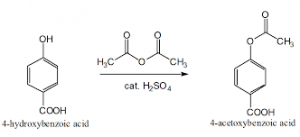Laboratory method of preparation acetic acid
Ethanoic Acid (Acetic acid – CH COOH)
Ethanoic acid is the second member of the homologous series of carboxylic acids. In other words, vinegar contains about 5 to 8% acetic acid. We will now describe two methods for the manufacture of ethanoic acid. In the first method, ethanoic acid is obtained as a dilute solution called vinegar.
Manufacture of Ethanoic Acid
From Ethanol
Ethanoic acid is manufactured in the form of vinegar by the bacterial oxidation of ethanol. Ethanol is oxidized by the oxygen of air in the presence of Acetobacter bacteria to form a dilute solution of ethanoic acid called vinegar. In this method, we get ethanoic acid in the form of a dilute solution in water called vinegar. So, we can also say that vinegar is prepared or manufactured by the oxidation of ethanol by air in the presence of Acetobacter bacteria.
From Methanol
Ethanoic acid is manufactured by the reaction between methanol and carbon monoxide in the presence of iridium – rhodium catalyst. This is a recent commercial method for preparing ethanoic acid.
Properties
- Ethanoic acid is a colourless liquid having a sour taste and a smell of vinegar.
- The boiling point of ethanoic acid is 118° C (391 K)
- When pure ethanoic acid is cooled, it freezes to form a colourless, ice like liquid.
- Ethanoic acid is miscible with water in all proportions.
Chemical Properties
- With Sodium or Sodium Hydroxide
Acetic acid reacts with sodium (or sodium hydroxide) and give sodium acetate.
- With Ammonia
It reacts with ammonia forming ammonium acetate and then on heating, acetamide is got.
iii. With phosphorus pentachloride
It combines with phosphorus pentachloride forming acetyl chloride,
phosphorus oxychloride and hydrochloric acid.
- Esterification
Activity
Take a few drops of acetic acid in a test tube. Add a few drops of ethanol to it. Then add a few drops of concentrated sulphuric acid in a test tube. Warm it in a water bath. Pour these contents in to a beaker containing water. What happens? A fruity odour comes from the beaker. The sweet smell is due to the formation of ester ethyl ethanote.
Acetic acid combines with ethyl alcohol in the presence of concentrated sulphuric acid to give ethyl acetate (which has a fruity odour) and water. It is called esterification and the produce Ethyl acetate is called ester.
- Dehydration
When vapours of acetic acid are passed through phosphorus pentoxide, acetic anhydride is obtained.
- Substitution Reaction
Chlorine reacts with acetic acid in diffused sunlight, in the presence of a catalyst like iron or phosphorus. Hydrogen atoms of CH group in acetic acid are replaced, step-by-step by chlorine atoms, forming monochloro acetic acid, dichloro acetic acid and trichloro acetic acid respectively.
Uses
- It is used for making cellulose acetate which is an important artificial fibre.
- It is used in the manufacture of acetone (propanone) and esters which are used in perfumes.
- Ethanoic acid is used in the preparation of dyes, plastics and drugs.
- Ethanoic acid is used to coagulate rubber from latex.
- Dilute ethanoic acid (in the form of vinegar) is used as a food preservative in the preparation of pickles and sauces.
- It is used for making white lead [2PbCO .Pb(OH) ] which is used as a white paint.
- Ethanoic acid is used as a reagent in chemistry laboratory.
- APSC Mains 2024 Tests and Notes Program
- APSC Prelims Exam 2020- Test Series and Notes Program
- Apsc Prelims and Mains 2024 Tests Series and Notes Program
- Apsc Detailed Complete Prelims Notes









